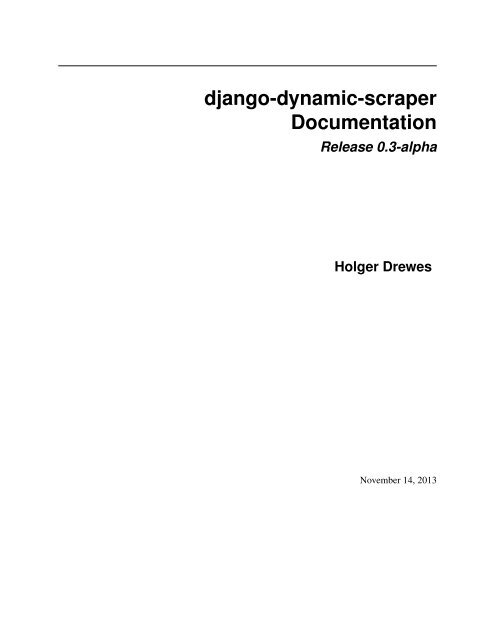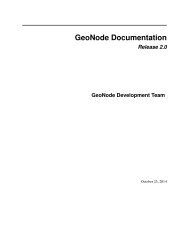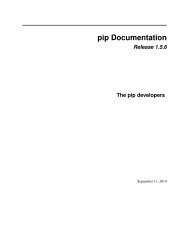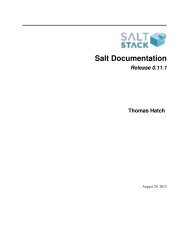django-dynamic-scraper Documentation Release ... - Read the Docs
django-dynamic-scraper Documentation Release ... - Read the Docs
django-dynamic-scraper Documentation Release ... - Read the Docs
You also want an ePaper? Increase the reach of your titles
YUMPU automatically turns print PDFs into web optimized ePapers that Google loves.
<strong>django</strong>-<strong>dynamic</strong>-<strong>scraper</strong><strong>Documentation</strong><strong>Release</strong> 0.3-alphaHolger DrewesNovember 14, 2013
Contentsi
<strong>django</strong>-<strong>dynamic</strong>-<strong>scraper</strong> <strong>Documentation</strong>, <strong>Release</strong> 0.3-alphaDjango Dynamic Scraper (DDS) is an app for Django build on top of <strong>the</strong> scraping framework Scrapy. While preservingmany of <strong>the</strong> features of Scrapy it lets you <strong>dynamic</strong>ally create and manage spiders via <strong>the</strong> Django admin interface.Contents 1
<strong>django</strong>-<strong>dynamic</strong>-<strong>scraper</strong> <strong>Documentation</strong>, <strong>Release</strong> 0.3-alpha2 Contents
CHAPTER 1Features• Create and manage <strong>scraper</strong>s for your Django models in <strong>the</strong> Django admin interface• Many features of Scrapy like regular expressions, processors, pipelines (see Scrapy <strong>Docs</strong>)• Image/screenshot scraping• Dynamic scheduling depending on crawling success via Django Celery• Checkers to check if items once scraped are still existingNote: DDS v.0.3 now officially supports Scrapy v.0.16.x!3
<strong>django</strong>-<strong>dynamic</strong>-<strong>scraper</strong> <strong>Documentation</strong>, <strong>Release</strong> 0.3-alpha4 Chapter 1. Features
CHAPTER 2User Manual2.1 Getting started2.1.1 IntroductionWith Django Dynamic Scraper (DDS) you can define your Scrapy <strong>scraper</strong>s <strong>dynamic</strong>ally via <strong>the</strong> Django admin interfaceand save your scraped items in <strong>the</strong> database you defined for your Django project. Since it simplifies things DDS isnot usable for all kinds of <strong>scraper</strong>s, but it is well suited for <strong>the</strong> relatively common case of regularly scraping a websitewith a list of updated items (e.g. news, events, etc.) and than dig into <strong>the</strong> detail page to scrape some more infos foreach item.Here are some examples for some use cases of DDS: Build a <strong>scraper</strong> for ...• Local music events for different event locations in your city• New organic recipes for asian food• The latest articles from blogs covering fashion and style in Berlin• ...Up to your imagination! :-)Django Dynamic Scraper tries to keep its data structure in <strong>the</strong> database as separated as possible from <strong>the</strong> models inyour app, so it comes with its own Django model classes for defining <strong>scraper</strong>s, runtime information related to your<strong>scraper</strong> runs and classes for defining <strong>the</strong> attributes of <strong>the</strong> models you want to scrape. So apart from a few foreign keyrelations your Django models stay relatively independent and you don’t have to adjust your model code every timeDDS’s model structure changes.The DDS repository on GitHub contains an example project in <strong>the</strong> example_project folder, showing how tocreate a <strong>scraper</strong> for open news content on <strong>the</strong> web (starting with Wikinews from Wikipedia). The source code fromthis example is used in <strong>the</strong> following guidelines.Warning: While <strong>the</strong>re is a testsuite for DDS with tests for most of its’ features and <strong>the</strong> app runs relatively stableand is also used in production, DDS is alpha and still in an early development phase. Expect API changes in futurereleases which will require manual adaption in your code. During alpha phase, API and/or DB changes can alsooccur after minor release updates (e.g. from 0.2.0 to 0.2.1).5
<strong>django</strong>-<strong>dynamic</strong>-<strong>scraper</strong> <strong>Documentation</strong>, <strong>Release</strong> 0.3-alpha2.1.2 InstallationRequirementsThe basic requirements for Django Dynamic Scraper are:• Python 2.7+ (earlier versions untested)• Django 1.4+ (also tested against Django 1.5)• Scrapy 0.16+If you want to use <strong>the</strong> scheduling mechanism of DDS you also have to install <strong>django</strong>-celery:• <strong>django</strong>-celery 3.0+For scraping images you will need <strong>the</strong> Python Image Library:• Python Image Libray (PIL) 1.1.7+ (earlier versions untested)And finally: DDS is using South for database migrations so that it’s easier to keep up with future DB changes:• South 0.7+ (earlier versions untested)Note: DDS v.0.3 is updating main library dependencies (Django, Scrapy, <strong>django</strong>-celery) to newer versions andyou have to change some stuff in your code if you are upgrading from DDS v.0.2.x, see <strong>Release</strong> Notes for details.Installation with PipDjango Dynamic Scraper can be found on <strong>the</strong> PyPI Package Index (see package description). For <strong>the</strong> installation withPip, first install <strong>the</strong> requirements above. Then install DDS with:pip install <strong>django</strong>-<strong>dynamic</strong>-<strong>scraper</strong>Manual InstallationFor manually installing Django Dynamic Scraper download <strong>the</strong> DDS source code from GitHub or clone <strong>the</strong> projectwith git into a folder of your choice:git clone https://github.com/holgerd77/<strong>django</strong>-<strong>dynamic</strong>-<strong>scraper</strong>.git .Then you have to met <strong>the</strong> requirements above. You can do this by manually installing <strong>the</strong> libraries you need withpip or easy_install, which may be a better choice if you e.g. don’t want to risk your Django installation to betouched during <strong>the</strong> installation process. However if you are sure that <strong>the</strong>re is no danger ahead or if you are runningDDS in a new virtualenv environment, you can install all <strong>the</strong> requirements above toge<strong>the</strong>r with:pip install -r requirements.txtThen ei<strong>the</strong>r add <strong>the</strong> <strong>dynamic</strong>_<strong>scraper</strong> folder to your PYTHONPATH or your project manually or install DDS with:python setup.py installNote, that <strong>the</strong> requirements are NOT included in <strong>the</strong> setup.py script since this caused some problems when testing<strong>the</strong> installation and <strong>the</strong> requirements installation process with pip turned out to be more stable.Now, to use DDS in your Django project add ’<strong>dynamic</strong>_<strong>scraper</strong>’ to your INSTALLED_APPS in your projectsettings.6 Chapter 2. User Manual
<strong>django</strong>-<strong>dynamic</strong>-<strong>scraper</strong> <strong>Documentation</strong>, <strong>Release</strong> 0.3-alpha2.1.3 Creating your Django modelsCreate your model classesWhen you want to build a Django app using Django Dynamic Scraper to fill up your models with data you have toprovide two model classes. The first class stores your scraped data, in our news example this is a class called Articlestoring articles scraped from different news websites. The second class is a reference class for this first model class,defining where <strong>the</strong> scraped items belong to. Often this class will represent a website, but it could also represent acategory, a topic or something similar. In our news example we call <strong>the</strong> class NewsWebsite. Below is <strong>the</strong> code forthis two model classes:from <strong>django</strong>.db import modelsfrom <strong>dynamic</strong>_<strong>scraper</strong>.models import Scraper, SchedulerRuntimefrom scrapy.contrib.<strong>django</strong>item import DjangoItemclass NewsWebsite(models.Model):name = models.CharField(max_length=200)url = models.URLField()<strong>scraper</strong> = models.ForeignKey(Scraper, blank=True, null=True, on_delete=models.SET_NULL)<strong>scraper</strong>_runtime = models.ForeignKey(SchedulerRuntime, blank=True, null=True, on_delete=models.SETdef __unicode__(self):return self.nameclass Article(models.Model):title = models.CharField(max_length=200)news_website = models.ForeignKey(NewsWebsite)description = models.TextField(blank=True)url = models.URLField()checker_runtime = models.ForeignKey(SchedulerRuntime, blank=True, null=True, on_delete=models.SETdef __unicode__(self):return self.titleclass ArticleItem(DjangoItem):<strong>django</strong>_model = ArticleAs you can see, <strong>the</strong>re are some foreign key fields defined in <strong>the</strong> models referencing DDS models. The NewsWebsiteclass has a reference to <strong>the</strong> Scraper DDS model, which contains <strong>the</strong> main <strong>scraper</strong> with information about how to scrape<strong>the</strong> attributes of <strong>the</strong> article objects. The <strong>scraper</strong>_runtime field is a reference to <strong>the</strong> SchedulerRuntime class from<strong>the</strong> DDS models. An object of this class stores scheduling information, in this case information about when to run anews website <strong>scraper</strong> for <strong>the</strong> next time. The NewsWebsite class also has to provide <strong>the</strong> url to be used during <strong>the</strong>scraping process. You can ei<strong>the</strong>r use (if existing) <strong>the</strong> representative url field of <strong>the</strong> model class, which is pointing to<strong>the</strong> nicely-layouted overview news page also visited by <strong>the</strong> user. In this case we are choosing this way with taking <strong>the</strong>url attribute of <strong>the</strong> model class as <strong>the</strong> scrape url. However, it often makes sense to provide a dedicated scrape_url(you can name <strong>the</strong> attribute freely) field for cases, when <strong>the</strong> representative url differs from <strong>the</strong> scrape url (e.g. if listcontent is loaded via ajax, or if you want to use ano<strong>the</strong>r format of <strong>the</strong> content - e.g. <strong>the</strong> rss feed - for scraping).The Article class to store scraped news articles also has a reference to <strong>the</strong> SchedulerRuntime DDS model classcalled checker_runtime. In this case <strong>the</strong> scheduling object holds information about <strong>the</strong> next existance check(using <strong>the</strong> url field from Article) to evaluate if <strong>the</strong> news article still exists or if it can be deleted (see Defining itemcheckers).Last but not least: Django Dynamic Scraper uses <strong>the</strong> DjangoItem class from Scrapy for being able to directly store<strong>the</strong> scraped data into <strong>the</strong> Django DB. You can store <strong>the</strong> item class (here: ArticleItem) telling Scrapy which model2.1. Getting started 7
<strong>django</strong>-<strong>dynamic</strong>-<strong>scraper</strong> <strong>Documentation</strong>, <strong>Release</strong> 0.3-alphaclass to use for storing <strong>the</strong> data directly underneath <strong>the</strong> associated model class.Note: For having a loose coupling between your runtime objects and your domain model objects you should declare<strong>the</strong> foreign keys to <strong>the</strong> DDS objects with <strong>the</strong> blank=True, null=True, on_delete=models.SET_NULLfield options. This will prevent a cascading delete of your reference object as well as <strong>the</strong> associated scraped objectswhen a DDS object is deleted accidentally.Deletion of objectsIf you delete model objects via <strong>the</strong> Django admin interface, <strong>the</strong> runtime objects are not deleted as well. If you wantthis to happen, you can use Django’s pre_delete signals in your models.py to delete e.g. <strong>the</strong> checker_runtimewhen deleting an article:@receiver(pre_delete)def pre_delete_handler(sender, instance, using, **kwargs):....if isinstance(instance, Article):if instance.checker_runtime:instance.checker_runtime.delete()pre_delete.connect(pre_delete_handler)2.1.4 Defining <strong>the</strong> object to be scrapedIf you have done everything right up till now and even synced your DB :-) your Django admin should look similar to<strong>the</strong> following screenshot below, at least if you follow <strong>the</strong> example project:8 Chapter 2. User Manual
<strong>django</strong>-<strong>dynamic</strong>-<strong>scraper</strong> <strong>Documentation</strong>, <strong>Release</strong> 0.3-alphaBefore being able to create <strong>scraper</strong>s in Django Dynamic Scraper you have to define which parts of <strong>the</strong> Django modelclass you defined above should be filled by your <strong>scraper</strong>. This is done via creating a new ScrapedObjClass in yourDjango admin interface and <strong>the</strong>n adding several ScrapedObjAttr datasets to it, which is done inline in <strong>the</strong> form for <strong>the</strong>ScrapedObjClass. The attributes for <strong>the</strong> object class have to be named like <strong>the</strong> attributes in your model class to bescraped. In our open news example we want <strong>the</strong> title, <strong>the</strong> description, and <strong>the</strong> url of an Article to be scraped, so weadd <strong>the</strong>se attributes with <strong>the</strong> corresponding names to <strong>the</strong> scraped obj class.The reason why we are redefining <strong>the</strong>se attributes here, is that we can later define x_path elements for each of <strong>the</strong>sesattributes <strong>dynamic</strong>ally in <strong>the</strong> <strong>scraper</strong>s we want to create. When Django Dynamic Scraper is scraping items, <strong>the</strong> generalworkflow of <strong>the</strong> scraping process is as follows:• The DDS <strong>scraper</strong> is scraping base elements from <strong>the</strong> overview page of items beeing scraped, with each baseelement encapsulating an item summary, e.g. in our open news example an article summary containing <strong>the</strong> titleof <strong>the</strong> article, a screenshot and a short description. The encapsuling html tag often is a div, but could also be atd tag or something else.• Then <strong>the</strong> DDS <strong>scraper</strong> is scraping <strong>the</strong> url from this item summary block, which leads to <strong>the</strong> detail page of <strong>the</strong>item• All <strong>the</strong> real item attributes (like a title, a description, a date or an image) are <strong>the</strong>n scraped ei<strong>the</strong>r from within <strong>the</strong>item summary block on <strong>the</strong> overview page or from <strong>the</strong> detail page of <strong>the</strong> item. This can be defined later whencreating <strong>the</strong> <strong>scraper</strong> itself.To define which of <strong>the</strong> scraped obj attributes are just simple standard attributes to be scraped, which one is <strong>the</strong>base attribute (this is a bit of an artificial construct) and which one is <strong>the</strong> url to be followed later, we have tochoose an attribute type for each attribute defined. There is a choice between <strong>the</strong> following types (taken from<strong>dynamic</strong>_<strong>scraper</strong>.models.ScrapedObjAttr):2.1. Getting started 9
<strong>django</strong>-<strong>dynamic</strong>-<strong>scraper</strong> <strong>Documentation</strong>, <strong>Release</strong> 0.3-alphaATTR_TYPE_CHOICES = ((’S’, ’STANDARD’),(’T’, ’STANDARD (UPDATE)’),(’B’, ’BASE’),(’U’, ’DETAIL_PAGE_URL’),(’I’, ’IMAGE’),)STANDARD, BASE and DETAIL_PAGE_URL should be clear by now, STANDARD (UPDATE) behaves likeSTANDARD, but <strong>the</strong>se attributes are updated with <strong>the</strong> new values if <strong>the</strong> item is already in <strong>the</strong> DB. IMAGE representsattributes which will hold images or screenshots. So for our open news example we define a base attribute called‘base’ with type BASE, two standard elements ‘title’ and ‘description’ with type STANDARD and a url field called ‘url’with type DETAIL_PAGE_URL. Your definition form for your scraped obj class should look similar to <strong>the</strong> screenshotbelow:Note: If you define an attribute as STANDARD (UPDATE) attribute and your <strong>scraper</strong> reads <strong>the</strong> value for this attributefrom <strong>the</strong> detail page of <strong>the</strong> item, your scraping process requires much more page requests, because <strong>the</strong> <strong>scraper</strong> hasto look at all <strong>the</strong> detail pages even for items already in <strong>the</strong> DB to compare <strong>the</strong> values. If you don’t use <strong>the</strong> updatefunctionality, use <strong>the</strong> simple STANDARD attribute instead!Note: Though it is a bit of a hack: if you want to scrape items on a website not leading to detail pages you can dothis by defining ano<strong>the</strong>r (non url) field as <strong>the</strong> DETAIL_PAGE_URL field, e.g. a title or an id. Make sure that this fieldis unique since <strong>the</strong> DETAIL_PAGE_URL field is also used as an identifier for preventing double entries in <strong>the</strong> DB anddon’t use <strong>the</strong> from_detail_page option in your <strong>scraper</strong> definitions. It is also not possible to use checkers withthis workaround. However: it works, I even wrote a unit test for this hack! :-)2.1.5 Defining your <strong>scraper</strong>sGeneral structure of a <strong>scraper</strong>Scrapers for Django Dynamic Scraper are also defined in <strong>the</strong> Django admin interface. You first have to give <strong>the</strong> <strong>scraper</strong>a name and select <strong>the</strong> associated ScrapedObjClass. In our open news example we call <strong>the</strong> <strong>scraper</strong> ‘Wikinews Scraper’and select <strong>the</strong> ScrapedObjClass named ‘Article’ defined above.The main part of defining a <strong>scraper</strong> in DDS is to create several <strong>scraper</strong> elements, each connected to a ScrapedObjAttrfrom <strong>the</strong> selected ScrapedObjClass. Each <strong>scraper</strong> element define how to extract <strong>the</strong> data for <strong>the</strong> specific ScrapedObjAttrby following <strong>the</strong> main concepts of Scrapy for scraping data from websites. In <strong>the</strong> fields named ‘x_path’and ‘reg_exp’ an XPath and (optionally) a regular expression is defined to extract <strong>the</strong> data from <strong>the</strong> page, followingScrapy’s concept of XPathSelectors. The ‘from_detail_page’ check box tells <strong>the</strong> <strong>scraper</strong>, if <strong>the</strong> data for <strong>the</strong> object10 Chapter 2. User Manual
<strong>django</strong>-<strong>dynamic</strong>-<strong>scraper</strong> <strong>Documentation</strong>, <strong>Release</strong> 0.3-alphaattibute for <strong>the</strong> <strong>scraper</strong> element should be extracted from <strong>the</strong> overview page or <strong>the</strong> detail page of <strong>the</strong> specific item.The fields ‘processors’ and ‘processors_ctxt’ are used to define output processors for your scraped data like <strong>the</strong>y aredefined in Scrapy’s Item Loader section. You can use <strong>the</strong>se processors e.g. to add a string to your scraped data or tobring a scraped date in a common format. More on this later. Finally, <strong>the</strong> ‘mandatory’ check box is indicating whe<strong>the</strong>r<strong>the</strong> data scraped by <strong>the</strong> <strong>scraper</strong> element is a necessary field. If you define a <strong>scraper</strong> element as necessary and no datacould be scraped for this element <strong>the</strong> item will be dropped. Note, that you always have to keep attributes mandatory,if <strong>the</strong> corresponding attributes of your domain model class is a mandatory field, o<strong>the</strong>rwise <strong>the</strong> scraped item can’t besaved in <strong>the</strong> DB.Creating <strong>the</strong> <strong>scraper</strong> of our open news exampleLet’s use <strong>the</strong> information above in <strong>the</strong> context of our Wikinews example. Below you see a screenshot of an html codeextract from <strong>the</strong> Wikinews overview page like it is displayed by <strong>the</strong> developer tools in Google’s Chrome browser:The next screenshot is from a news article detail page:We will use <strong>the</strong>se code snippets in our examples.Note: If you don’t want to manually create <strong>the</strong> necessary DB objects for <strong>the</strong> example project, you can also runpython manage.py loaddata open_news/open_news.json from within <strong>the</strong> example_project directoryin your favorite shell to have all <strong>the</strong> objects necessary for <strong>the</strong> example created automatically .Note: The WikiNews site changes its code from time to time. I will try to update <strong>the</strong> example code and text in <strong>the</strong>docs, but I won’t keep pace with <strong>the</strong> screenshots so <strong>the</strong>y can differ slightly compared to <strong>the</strong> real world example.1. First we have to define a base <strong>scraper</strong> element to get <strong>the</strong> enclosing DOM elements for news item summaries.On <strong>the</strong> Wikinews overview page all news summaries are enclosed by tags with a class called ‘l_box’, so//td[@class="l_box"] should do <strong>the</strong> trick. We leave <strong>the</strong> rest of <strong>the</strong> field for <strong>the</strong> <strong>scraper</strong> element on default.2. It is not necessary but just for <strong>the</strong> purpose of this example let’s scrape <strong>the</strong> title of a news article from <strong>the</strong> article detailpage. On an article detail page <strong>the</strong> headline of <strong>the</strong> article is enclosed by a tag with an id named ‘firstHeading’.So //h1[@id="firstHeading"]/span/text() should give us <strong>the</strong> headline. Since we want to scrape from<strong>the</strong> detail page, we have to activate <strong>the</strong> ‘from_detail_page’ check box.3. All <strong>the</strong> standard elements we want to scrape from <strong>the</strong> overview page are defined relative to <strong>the</strong> base element.Therefore keep in mind to leave <strong>the</strong> trailing double slashes of XPath definitions. We scrape <strong>the</strong> shortdescription of a news item from within a tag with a class named ‘l_summary’. So <strong>the</strong> XPath isp/span[@class="l_summary"]/text().2.1. Getting started 11
<strong>django</strong>-<strong>dynamic</strong>-<strong>scraper</strong> <strong>Documentation</strong>, <strong>Release</strong> 0.3-alpha4. And finally <strong>the</strong> url can be scraped via <strong>the</strong> XPath span[@class="l_title"]/a/@href. Since we onlyscrape <strong>the</strong> path of our url with this XPath and not <strong>the</strong> domain, we have to use a processor for <strong>the</strong> first time tocomplete <strong>the</strong> url. For this purpose <strong>the</strong>re is a predefined processor called ‘pre_url’. You can find more predefinedprocessors in <strong>the</strong> <strong>dynamic</strong>_<strong>scraper</strong>.utils.processors module. ‘pre_url’ is simply doing what we want,namely adding a base url string to <strong>the</strong> scraped string. To use a processor, just write <strong>the</strong> function name in <strong>the</strong> processorfield. Processors can be given some extra information via <strong>the</strong> processors_ctxt field. In our case we need <strong>the</strong> speficbase url our scraped string should be appended to. Processor context information is provided in a dictionary likeform: ’processor_name’: ’context’, in our case: ’pre_url’: ’http://en.wikinews.org’.Toge<strong>the</strong>r with our scraped string this will create <strong>the</strong> complete url.This completes our <strong>scraper</strong>. The form you have filled out should look similar to <strong>the</strong> screenshot above (which is brokendown to two rows due to space issues).Note: You can also scrape attributes of your object from outside <strong>the</strong> base element by using <strong>the</strong> .. notation in yourXPath expressions to get to <strong>the</strong> parent nodes!Create <strong>the</strong> domain entity reference object (NewsWebsite) for our open news exampleNow - finally - we are just one step away of having all objects created in our Django admin. The last dataset we haveto add is <strong>the</strong> reference object of our domain, meaning a NewsWebsite object for <strong>the</strong> Wikinews Website.To do this open <strong>the</strong> NewsWebsite form in <strong>the</strong> Django admin, give <strong>the</strong> object a meaningful name (‘Wikinews’), assign<strong>the</strong> <strong>scraper</strong> and create an empty SchedulerRuntime object with SCRAPER as your runtime_type.12 Chapter 2. User Manual
<strong>django</strong>-<strong>dynamic</strong>-<strong>scraper</strong> <strong>Documentation</strong>, <strong>Release</strong> 0.3-alpha2.1.6 Setting up Scrapy/Create necessary python modules for your appNow after having created <strong>the</strong> Django models we want to scrape and having created <strong>the</strong> <strong>scraper</strong> and associated objectsin <strong>the</strong> database we have to set up Scrapy and get it to work toge<strong>the</strong>r with <strong>the</strong> stuff we have created. To get this going,we have to create a new Scrapy project, adjust some settings in <strong>the</strong> configuration and create two short python modulefiles, one with a spider class, inheriting from DjangoSpider, and a finalising pipeline for saving our scraped objects.Setting up ScrapyFor getting Scrapy to work <strong>the</strong> recommended way to start a new Scrapy project normally is to create a directory andtemplate file structure with <strong>the</strong> scrapy startproject myscrapyproject command on <strong>the</strong> shell first. However,<strong>the</strong>re is (initially) not so much code to be written left and <strong>the</strong> directory structure created by <strong>the</strong> startprojectcommand cannot really be used when connecting Scrapy to <strong>the</strong> Django Dynamic Scraper library. So <strong>the</strong> easiest wayto start a new scrapy project is to just manually add <strong>the</strong> scrapy.cfg project configuration file as well as <strong>the</strong> Scrapysettings.py file and adjust <strong>the</strong>se files to your needs. It is recommended to just create <strong>the</strong> Scrapy project in <strong>the</strong>same Django app you used to create <strong>the</strong> models you want to scrape and <strong>the</strong>n place <strong>the</strong> modules needed for scrapy ina sub package called <strong>scraper</strong> or something similar. After finishing this chapter you should end up with a directorystructure similar to <strong>the</strong> following (again illustrated using <strong>the</strong> open news example):example_project/scrapy.cfgopen_news/models.py # Your models.py file<strong>scraper</strong>/settings.pyspiders.py(checkers.py)pipelines.py(tasks.py)Your scrapy.cfg file should look similar to <strong>the</strong> following, just having adjusted <strong>the</strong> reference to <strong>the</strong> settings file and<strong>the</strong> project name:[settings]default = open_news.<strong>scraper</strong>.settings[deploy]#url = http://localhost:6800/project = open_news2.1. Getting started 13
<strong>django</strong>-<strong>dynamic</strong>-<strong>scraper</strong> <strong>Documentation</strong>, <strong>Release</strong> 0.3-alphaAnd this is your settings.py file:import osPROJECT_ROOT = os.path.abspath(os.path.dirname(__file__))os.environ.setdefault("DJANGO_SETTINGS_MODULE", "example_project.settings") #Changed in DDS v.0.3BOT_NAME = ’open_news’SPIDER_MODULES = [’<strong>dynamic</strong>_<strong>scraper</strong>.spiders’, ’open_news.<strong>scraper</strong>’,]USER_AGENT = ’%s/%s’ % (BOT_NAME, ’1.0’)ITEM_PIPELINES = [’<strong>dynamic</strong>_<strong>scraper</strong>.pipelines.ValidationPipeline’,’open_news.<strong>scraper</strong>.pipelines.DjangoWriterPipeline’,]The SPIDER_MODULES setting is referencing <strong>the</strong> basic spiders of DDS and our <strong>scraper</strong> package where Scrapywill find <strong>the</strong> (yet to be written) spider module. For <strong>the</strong> ITEM_PIPELINES setting we have to add (at least) twopipelines. The first one is <strong>the</strong> mandatory pipeline from DDS, doing stuff like checking for <strong>the</strong> mandatory attributeswe have defined in our <strong>scraper</strong> in <strong>the</strong> DB or preventing double entries already existing in <strong>the</strong> DB (identified by <strong>the</strong> urlattribute of your scraped items) to be saved a second time.Adding <strong>the</strong> spider classThe main work left to be done in our spider class - which is inheriting from <strong>the</strong> DjangoSpider class of Django DynamicScraper - is to instantiate <strong>the</strong> spider by connecting <strong>the</strong> domain model classes to it in <strong>the</strong> __init__ function:from <strong>dynamic</strong>_<strong>scraper</strong>.spiders.<strong>django</strong>_spider import DjangoSpiderfrom open_news.models import NewsWebsite, Article, ArticleItemclass ArticleSpider(DjangoSpider):name = ’article_spider’def __init__(self, *args, **kwargs):self._set_ref_object(NewsWebsite, **kwargs)self.<strong>scraper</strong> = self.ref_object.<strong>scraper</strong>self.scrape_url = self.ref_object.urlself.scheduler_runtime = self.ref_object.<strong>scraper</strong>_runtimeself.scraped_obj_class = Articleself.scraped_obj_item_class = ArticleItemsuper(ArticleSpider, self).__init__(self, *args, **kwargs)Adding <strong>the</strong> pipeline classSince you maybe want to add some extra attributes to your scraped items, DDS is not saving <strong>the</strong> scraped items for youbut you have to do it manually in your own item pipeline:from <strong>django</strong>.db.utils import IntegrityErrorfrom scrapy import logfrom scrapy.exceptions import DropItemfrom <strong>dynamic</strong>_<strong>scraper</strong>.models import SchedulerRuntimeclass DjangoWriterPipeline(object):14 Chapter 2. User Manual
<strong>django</strong>-<strong>dynamic</strong>-<strong>scraper</strong> <strong>Documentation</strong>, <strong>Release</strong> 0.3-alphadef process_item(self, item, spider):try:item[’news_website’] = spider.ref_objectchecker_rt = SchedulerRuntime(runtime_type=’C’)checker_rt.save()item[’checker_runtime’] = checker_rtitem.save()spider.action_successful = Truespider.log("Item saved.", log.INFO)except IntegrityError, e:spider.log(str(e), log.ERROR)raise DropItem("Missing attribute.")return itemThe things you always have to do here is adding <strong>the</strong> reference object to <strong>the</strong> scraped item class and - if you are usingchecker functionality - create <strong>the</strong> runtime object for <strong>the</strong> checker. You also have to set <strong>the</strong> action_successfulattribute of <strong>the</strong> spider, which is used internally by DDS when <strong>the</strong> spider is closed.2.1.7 Running/Testing your <strong>scraper</strong>You can run/test spiders created with Django Dynamic Scraper from <strong>the</strong> command line similar to how you would runyour normal Scrapy spiders, but with some additional arguments given. The syntax of <strong>the</strong> DDS spider run commandis as following:scrapy crawl SPIDERNAME -a id=REF_OBJECT_ID[-a do_action=(yes|no) -a run_type=(TASK|SHELL)-a max_items_read={Int} -a max_items_save={Int}]• With -a id=REF_OBJECT_ID you provide <strong>the</strong> ID of <strong>the</strong> reference object items should be scraped for, inour example case that would be <strong>the</strong> Wikinews NewsWebsite object, probably with ID 1 if you haven’t addedo<strong>the</strong>r objects before. This argument is mandatory.• By default, items scraped from <strong>the</strong> command line are not saved in <strong>the</strong> DB. If you want this to happen, you haveto provide -a do_action=yes.• With -a run_type=(TASK|SHELL) you can simulate task based <strong>scraper</strong> runs invoked from <strong>the</strong> commandline. This can be useful for testing, just leave this argument for now.• With -a max_items_read={Int} and -a max_items_save={Int} you can override <strong>the</strong> <strong>scraper</strong>settings for <strong>the</strong>se params.So, to invoke our Wikinews <strong>scraper</strong>, we have <strong>the</strong> following command:scrapy crawl article_spider -a id=1 -a do_action=yesIf you have done everything correctly (which would be a bit unlikely for <strong>the</strong> first run after so many single steps, butjust in <strong>the</strong>ory... :-)), you should get some output similar to <strong>the</strong> following, of course with o<strong>the</strong>r headlines:2.1. Getting started 15
<strong>django</strong>-<strong>dynamic</strong>-<strong>scraper</strong> <strong>Documentation</strong>, <strong>Release</strong> 0.3-alphaIn your Django admin interface you should now see <strong>the</strong> scraped articles listed on <strong>the</strong> article overview page:Phew.Your first <strong>scraper</strong> with Django Dynamic Scraper is working. Not so bad! If you do a second run and <strong>the</strong>re haven’tbeen any new bugs added to <strong>the</strong> DDS source code in <strong>the</strong> meantime, no extra article objects should be added to <strong>the</strong> DB.If you try again later when some news articles changed on <strong>the</strong> Wikinews overview page, <strong>the</strong> new articles should beadded to <strong>the</strong> DB.16 Chapter 2. User Manual
<strong>django</strong>-<strong>dynamic</strong>-<strong>scraper</strong> <strong>Documentation</strong>, <strong>Release</strong> 0.3-alpha2.2 Advanced topics2.2.1 Defining item checkersDjango Dynamic Scraper comes with a built-in mechanism to check, if items once scraped are still existing or if <strong>the</strong>ycould be deleted from <strong>the</strong> database. The entity providing this mechanism in DDS is called an item checker. An itemchecker is like a <strong>scraper</strong> also using <strong>the</strong> scraping logic from Scrapy. But instead of building toge<strong>the</strong>r a new scrapeditem, it just checks <strong>the</strong> detail page referenced by <strong>the</strong> url of a scraped item. Depending on <strong>the</strong> checker_type and<strong>the</strong> result of <strong>the</strong> detail page check, <strong>the</strong> scraped item is kept or will be deleted from <strong>the</strong> DB.Creating a checker classTo get a checker up and running you first have to create a checker class for each of your scraped object domain models.In our open news example, this would be a class called ArticleChecker in a module called checkers in our<strong>scraper</strong> directory:from <strong>dynamic</strong>_<strong>scraper</strong>.spiders.<strong>django</strong>_checker import DjangoCheckerfrom open_news.models import Articleclass ArticleChecker(DjangoChecker):name = ’article_checker’def __init__(self, *args, **kwargs):self._set_ref_object(Article, **kwargs)self.<strong>scraper</strong> = self.ref_object.news_website.<strong>scraper</strong>self.scrape_url = self.ref_object.urlself.scheduler_runtime = self.ref_object.checker_runtimesuper(ArticleChecker, self).__init__(self, *args, **kwargs)The checker class inherits from <strong>the</strong> DjangoChecker class from DDS and mainly gives <strong>the</strong> checker <strong>the</strong> informationwhat to check and what parameters to use for checking. Be careful that <strong>the</strong> reference object is now <strong>the</strong> scrapedobject itself, since <strong>the</strong> checker is scraping from <strong>the</strong> item page url of this object. The url field to check is set withself.scrape_url = self.ref_object.url. Fur<strong>the</strong>rmore <strong>the</strong> checker needs its configuration data from<strong>the</strong> <strong>scraper</strong> of <strong>the</strong> reference object. The scheduler runtime is used to schedule <strong>the</strong> next check. So if you want to usecheckers for your scraped object, you have to provide a foreign key to a SchedulerRuntime object in your model class.The scheduler runtime object also has to be saved manually in your pipeline class (see: Adding <strong>the</strong> pipeline class).Select checker type/set check parametersThere are momentarily <strong>the</strong> following checker types to choose from:404 Item is deleted after check has returned 404 HTTP status code 2x in a row404_OR_X_PATH Same as 404 + check for an x_path value in <strong>the</strong> resultThe checker type and <strong>the</strong> x_path parameters when choosing 404_OR_X_PATH as checker type are defined in <strong>the</strong>Django admin forms of <strong>the</strong> different <strong>scraper</strong>s:2.2. Advanced topics 17
<strong>django</strong>-<strong>dynamic</strong>-<strong>scraper</strong> <strong>Documentation</strong>, <strong>Release</strong> 0.3-alphaFor selecting a checker type and providing <strong>the</strong> parameters for an x_path checker you have to look for an example itempage url from <strong>the</strong> website to be scraped which references an item not existing any more. If <strong>the</strong> urls to your scrapeditems are build using an item ID you can e.g. try to lower this ID or increase it to a very large number. Be creative! Inour Wikinews example it is a bit different, since <strong>the</strong> news article url <strong>the</strong>re is build using <strong>the</strong> title of <strong>the</strong> article. So for<strong>the</strong> checker we take a random article url to a not existing article: “http://en.wikinews.org/wiki/Random_article_text”.If your url found is responding with a 404 when invoked, you can simply choose 404 as yourchecker type. For a 404_OR_X_PATH checker you have to provide an XPath for your chosen urlwhich will extract a string from that url uniquely indicating, that <strong>the</strong> content originally expected isnot <strong>the</strong>re any more. For our Wikinews example and <strong>the</strong> url we choose above <strong>the</strong>re is a text anda url provided suggesting to create <strong>the</strong> currently not existing wiki page, so we can use <strong>the</strong> XPath//a[@href="http://en.wikinews.org/wiki/This_wiki_article_doesnt_exist"]/text()and <strong>the</strong> result string “create this page” to uniquely identifying a scraped item not existing any more.Note: Attention! Make sure that <strong>the</strong> XPath/result string combination you choose is NOT succeeding on normal itempages, o<strong>the</strong>rwise <strong>the</strong> checker will delete all your items!Note: To make sure your items aren’t deleted accidentally on a 404 response, 404 checks are only deleted on <strong>the</strong>second try while XPath checks are deleted at once. So to save crawling resources always try to realize your checkingwith XPath checks, o<strong>the</strong>rwise <strong>the</strong> crawler need double <strong>the</strong> amount of checks!Running your checkersYou can test your DDS checkers <strong>the</strong> same way you would run your <strong>scraper</strong>s:scrapy crawl CHECKERNAME -a id=REF_OBJECT_ID [-a do_action=(yes|no) -a run_type=(TASK|SHELL)]As a reference object ID you now have to provide <strong>the</strong> ID of a scraped item to be checked. With do_action=yes anitem is really deleted, o<strong>the</strong>rwise <strong>the</strong> checker is only tested without actually manipulating <strong>the</strong> DB.If you want to test a check on an item scraped in <strong>the</strong> open news example project, change <strong>the</strong> url of <strong>the</strong> item in <strong>the</strong> DBto <strong>the</strong> checker reference url, look for <strong>the</strong> item ID and <strong>the</strong>n run:scrapy crawl article_checker -a id=ITEM_ID -a do_action=yesIf everything works well, your item should have been deleted.Run checker testsDjango Dynamic Scraper comes with a build-in <strong>scraper</strong> called checker_test which can be used to test yourcheckers against <strong>the</strong> defined reference url. You can run this checker on <strong>the</strong> command line with <strong>the</strong> following command:18 Chapter 2. User Manual
<strong>django</strong>-<strong>dynamic</strong>-<strong>scraper</strong> <strong>Documentation</strong>, <strong>Release</strong> 0.3-alphascrapy crawl checker_test -a id=SCRAPER_IDThis <strong>scraper</strong> is useful both to look, if you have chosen a valid checker_x_path_ref_url and correspondingchecker_x_path and checker_x_path_result values as well as to see over time if your reference urls stayvalid. For this use case <strong>the</strong>re exists a pre-defined celery task called run_checker_tests which can be used to run<strong>the</strong> checker test for all <strong>the</strong> <strong>scraper</strong>s having a valid checker configuration. If a checker breaks over time (e.g. through arenewed “Item not found” page) an error message will occur in <strong>the</strong> log table in <strong>the</strong> Django admin.2.2.2 Scheduling <strong>scraper</strong>s/checkersIntroductionDjango Dynamic Scraper comes with a build-in mechanism to schedule <strong>the</strong> runs of your <strong>scraper</strong>s as well as yourcheckers. After each run DDS <strong>dynamic</strong>ally calculates <strong>the</strong> next execution time depending on <strong>the</strong> success of <strong>the</strong> run. Fora <strong>scraper</strong> that means, that <strong>the</strong> time between two <strong>scraper</strong> runs is shortened when new items could be scraped from a pageand is prolonged if not. For a checker, it means that a next check is prolonged if <strong>the</strong> check was not successful, meaningthat <strong>the</strong> item was not deleted. If it was deleted - well: than it was deleted! No fur<strong>the</strong>r action! :-) The parameters forthis calculation (e.g. a min/max time period between two actions) are defined for each ScrapedObjClass in <strong>the</strong> DB.DDS is using <strong>django</strong>-celery to actually run your <strong>scraper</strong>s. Celery is a distributed task queue system for Python, whichmeans that you can run a celery daemon which takes task orders from somewhere and <strong>the</strong>n executes <strong>the</strong> correspondingtasks in a sequential way so that no task is lost, even if <strong>the</strong> system is under heavy load. In our use case Celery is“just” working as a comfortable cron job replacement, which can be controlled via <strong>the</strong> Django admin interface. Thescheduler of DDS is using <strong>the</strong> scheduler runtime objects we defined for our example <strong>scraper</strong> and checker in <strong>the</strong> sectionsbefore. The scheduler runtime objects contain some <strong>dynamic</strong> information for <strong>the</strong> calculation of <strong>the</strong> next execution timeof <strong>the</strong> <strong>scraper</strong> as well as <strong>the</strong> next execution time itself. For <strong>django</strong>-celery a task for each ScrapedObjClass has to bedefined, which can than be started and stopped in <strong>the</strong> Django admin interface. Each task is executed periodically in aconfigurable time frame (e.g. ever hour). The task is <strong>the</strong>n running all <strong>the</strong> <strong>scraper</strong>s associated with its ScrapedObjClass,which next execution time lies in <strong>the</strong> past. After each run, <strong>the</strong> next next execution time is calculated by <strong>the</strong> <strong>scraper</strong> andsaved into its scheduler runtime object. The next time this time lies in <strong>the</strong> past, <strong>the</strong> <strong>scraper</strong> is run again.Note: The number of spiders/checkers run at each task run is limited by <strong>the</strong>DSCRAPER_MAX_SPIDER_RUNS_PER_TASK and DSCRAPER_MAX_CHECKER_RUNS_PER_TASK settingswhich can be adopted in your custom settings file (see: Settings).Installing/configuring <strong>django</strong>-celery for DDSThis paragraph is covering only <strong>the</strong> specific installation issues with <strong>django</strong>-celery in regard of installing it for <strong>the</strong> usewith DDS, so you should be familiar with <strong>the</strong> basic functionality of Celery and take general installation infos from <strong>the</strong><strong>django</strong>-celery website. If you have successfully installed and configured <strong>django</strong>-celery, you should see <strong>the</strong> Djcelerytables in <strong>the</strong> Django admin interface:2.2. Advanced topics 19
<strong>django</strong>-<strong>dynamic</strong>-<strong>scraper</strong> <strong>Documentation</strong>, <strong>Release</strong> 0.3-alphaFor <strong>django</strong>-celery to work, Celery also needs a message broker for <strong>the</strong> actual message transport. For our relativelysimple use case, kombu is <strong>the</strong> easiest and recommended choice. Kombu is automatically installed as a dependencywhen you install <strong>django</strong>-celery and you can add it to your INSTALLED_APPS:)INSTALLED_APPS = (...’kombu.transport.<strong>django</strong>’,’djcelery’,Then we can configure <strong>django</strong>-celery in combination with kombu in our settings.py file. A starter configurationcould look similar to this:# <strong>django</strong>-celery settingsimport djcelerydjcelery.setup_loader()BROKER_HOST = "localhost"BROKER_PORT = 5672BROKER_BACKEND = "<strong>django</strong>"BROKER_USER = "guest"BROKER_PASSWORD = "guest"BROKER_VHOST = "/"CELERYBEAT_SCHEDULER = ’djcelery.schedulers.DatabaseScheduler’20 Chapter 2. User Manual
<strong>django</strong>-<strong>dynamic</strong>-<strong>scraper</strong> <strong>Documentation</strong>, <strong>Release</strong> 0.3-alphaDefining your tasksFor defining tasks for your <strong>scraper</strong>s and checkers which can be selected for periodical runs in <strong>the</strong> Django admininterface, you have to define two short methods in a Python module in which your tasks are declared and make sure,that your tasks are found by <strong>django</strong>-celery. The easiest way to do this is by placing your methods in a module calledtasks.py in <strong>the</strong> main directory of your app. The tasks should <strong>the</strong>n be found automatically. The two methods in ouropen news example look like this:from celery.task import taskfrom <strong>dynamic</strong>_<strong>scraper</strong>.utils.task_utils import TaskUtilsfrom open_news.models import NewsWebsite, Article@task()def run_spiders():t = TaskUtils()t.run_spiders(NewsWebsite, ’<strong>scraper</strong>’, ’<strong>scraper</strong>_runtime’, ’article_spider’)@task()def run_checkers():t = TaskUtils()t.run_checkers(Article, ’news_website__<strong>scraper</strong>’, ’checker_runtime’, ’article_checker’)The two methods are decorated with <strong>the</strong> Celery task decorator to tell Celery that <strong>the</strong>se methods should be regarded astasks. In each task, a method from <strong>the</strong> TaskUtils module from DDS is called to run <strong>the</strong> spiders/checkers ready for<strong>the</strong> next execution.Now you can create a peridoc task both for your <strong>scraper</strong> and your checker in <strong>the</strong> Django admin interface:In <strong>the</strong> peridoc task form you should be able to select your tasks defined above. Create an interval how often <strong>the</strong>setasks are performed. In our open news example, 2 hours should be a good value. Please keep in mind, that <strong>the</strong>se are2.2. Advanced topics 21
<strong>django</strong>-<strong>dynamic</strong>-<strong>scraper</strong> <strong>Documentation</strong>, <strong>Release</strong> 0.3-alphanot <strong>the</strong> values how often a <strong>scraper</strong>/checker is actually run. If you define a two hour timeframe here, it just means,that ever two hours, <strong>the</strong> task method executed is checking for <strong>scraper</strong>s/checkers with a next execution time (defined by<strong>the</strong> associated scheduler_runtime) lying in <strong>the</strong> past and run <strong>the</strong>se <strong>scraper</strong>s. The actual time period between tworuns is determined by <strong>the</strong> next execution time itself which is calculated <strong>dynamic</strong>ally and depending on <strong>the</strong> schedulingconfiguration you’ll learn more about below. For <strong>the</strong> <strong>scraper</strong>s to run, remember also that you have to set <strong>the</strong> <strong>scraper</strong>active in <strong>the</strong> associated <strong>scraper</strong> object.Run your tasksTo actually run <strong>the</strong> task (respectively set our scheduling system to work as a whole) we have to run two differentdaemon processes. The first one is <strong>the</strong> celeryd daemon from <strong>django</strong>-celery which is responsible for collecting andexecuting tasks. We have to run celeryd with <strong>the</strong> -B option to also run <strong>the</strong> celerybeat task scheduler which executesperiodical tasks defined in Celery. Start <strong>the</strong> daemon with:python manage.py celeryd -l info -B --settings=example_project.settingsIf everything works well, you should now see <strong>the</strong> following line in your command line output:[2011-12-12 10:20:01,535: INFO/MainProcess] Celerybeat: Starting...As a second daemon process we need <strong>the</strong> server coming along with Scrapy to actually crawl <strong>the</strong> different websitestargeted with our <strong>scraper</strong>s. You can start <strong>the</strong> Scrapy Server with <strong>the</strong> following command from within <strong>the</strong> main directoryof your project:scrapy serverYou should get an output similar to <strong>the</strong> following:For testing your scheduling system, you can temporarily set your time interval of your periodic task to a lower interval,e.g. 1 minute. Now you should see a new task coming in and being executed every minute:Got task from broker: open_news.tasks.run_spiders[5a3fed53-c26a-4f8f-b946-8c4a2c7c5c83]Task open_news.tasks.run_spiders[5a3fed53-c26a-4f8f-b946-8c4a2c7c5c83] succeeded in 0.052549123764s:The executed task should <strong>the</strong>n run <strong>the</strong> <strong>scraper</strong>s/checkers which you should see in <strong>the</strong> output of <strong>the</strong> Scrapy server:Process started: project=’default’ spider=’article_spider’ job=’41f27199259e11e192041093e90a480a’ pidProcess finished: project=’default’ spider=’article_spider’ job=’41f27199259e11e192041093e90a480a’ piNote: Note that you can vary <strong>the</strong> log level for debugging as well as o<strong>the</strong>r run parameters when you start <strong>the</strong> servers,see <strong>the</strong> man/help pages of <strong>the</strong> celery and <strong>the</strong> Scrapy daemons.Note: Please see this configuration described here just as a hint to get started. If you want to use this in productionyou have to provide extra measures to make sure that your servers run constantly and that <strong>the</strong>y are secure. See <strong>the</strong>specific server documentation for more information.22 Chapter 2. User Manual
<strong>django</strong>-<strong>dynamic</strong>-<strong>scraper</strong> <strong>Documentation</strong>, <strong>Release</strong> 0.3-alphaScheduling configurationNow coming to <strong>the</strong> little bit of magic added to all this stuff with <strong>dynamic</strong> scheduling. The basis for <strong>the</strong> <strong>dynamic</strong>scheduling in DDS is layed both for your <strong>scraper</strong>s and your checkers with <strong>the</strong> scheduling configuration parameters inyour scraped object class definitions in <strong>the</strong> Django admin interface. The default configuration for a <strong>scraper</strong> looks likethis:"MIN_TIME": 15,"MAX_TIME": 10080,"INITIAL_NEXT_ACTION_FACTOR": 10,"ZERO_ACTIONS_FACTOR_CHANGE": 20,"FACTOR_CHANGE_FACTOR": 1.3,Scheduling now works as follows: <strong>the</strong> inital time period between two <strong>scraper</strong> runs is calculated by taking <strong>the</strong> productof <strong>the</strong> MIN_TIME and <strong>the</strong> INITIAL_NEXT_ACTION_FACTOR, with minutes as <strong>the</strong> basic time unit for MIN_TIMEand MAX_TIME:initial time period := 15 Minutes (MIN_TIME) * 10 (INITIAL_NEXT_ACTION_FACTOR) = 150 Minutes = 2 1/2Now, every time a <strong>scraper</strong> run was successful, <strong>the</strong> new next action factor is calculated by dividing <strong>the</strong> actual next actionfactor by <strong>the</strong> FACTOR_CHANGE_FACTOR. So a successful <strong>scraper</strong> run would lead to <strong>the</strong> following new time period:new next action factor (NAF) := 10 (INITIAL_NEXT_ACTION_FACTOR) / 1.3 (FACTOR_CHANGE_FACTOR) = 7.69 (time period after successful run := 15 Minutes * 7.69 (NAF) = 115 MinutesSo if it turns out that your <strong>scraper</strong> always find new items <strong>the</strong> time period between two runs gets smaller and smalleruntil <strong>the</strong> defined MIN_TIME is reached which is taken as a minimum time period between two <strong>scraper</strong> runs. If your<strong>scraper</strong> was not successful (meaning, that no new items were found) <strong>the</strong>se unsucessful actions (<strong>scraper</strong> runs) arecounted as ZERO_ACTIONS. If a number of unsuccessful actions greater than ZERO_ACTIONS_FACTOR_CHANGEis counted, a new next action factor is calculated, this time by taking <strong>the</strong> product of <strong>the</strong> actual action factor and <strong>the</strong>FACTOR_CHANGE_FACTOR (calculation restarting from initial values for <strong>the</strong> example):new next action factor (NAF) := 10 (INITIAL_NEXT_ACTION_FACTOR) * 1.3 (FACTOR_CHANGE_FACTOR) = 13time period after 21 unsuccessful runs := 15 Minutes * 13 (NAF) = 195 MinutesSo <strong>the</strong> time period between two <strong>scraper</strong> runs becomes larger. If <strong>the</strong>re is never a new item found for your <strong>scraper</strong> thiswill go on until <strong>the</strong> calculated time period reaches <strong>the</strong> MAX_TIME defined.In <strong>the</strong> real world application of this mechanism normally nei<strong>the</strong>r <strong>the</strong> MIN_TIME nor <strong>the</strong> MAX_TIME should bereached. The normal situation is that your <strong>scraper</strong> often finds nothing new on <strong>the</strong> page to be scraped and than afterx executed runs finds new items provided on <strong>the</strong> website to be scraped. If this x is generally lower than yourdefined ZERO_ACTIONS_FACTOR_CHANGE number, <strong>the</strong> time period is becoming shorter over time. But since thismeans more <strong>scraper</strong> runs in <strong>the</strong> same time chances are high that with <strong>the</strong>se narrower scheduled runs less zero actionsoccur and leads at some point to an again increased next action factor. So some kind of (relatively) stable next actionfactor should be reached over time, representing in <strong>the</strong> best case a good compromise between <strong>the</strong> needs of actuality ofyour <strong>scraper</strong>s and not to much resources wasted on running your <strong>scraper</strong> on websites not updated in between two runs.Note: Since this is a relatively complex mechanism also depending on a large part on <strong>the</strong> update process of yourscraped website, it will probably take some time to get a bit a feeling for how <strong>the</strong> scheduling is developing and to whataction factors it tends to, so don’t try to find <strong>the</strong> perfect solution in <strong>the</strong> first run. Instead, start with a (maybe ra<strong>the</strong>r tooconservatively calculated) start configuration and adjust your parameters over time. You can observe <strong>the</strong> developmentof your action factors in <strong>the</strong> scheduler runtime objects.Note: Please be aware that scraping is a resource consuming task, for your server but as well for <strong>the</strong> server of <strong>the</strong>websites you are scraping. Try to find a balanced solution, not just setting your MIN_TIME to 1 minute or similar.2.2. Advanced topics 23
<strong>django</strong>-<strong>dynamic</strong>-<strong>scraper</strong> <strong>Documentation</strong>, <strong>Release</strong> 0.3-alphaNote: If you don’t need <strong>dynamic</strong> scheduling, you can also just set <strong>the</strong> MIN_TIME and <strong>the</strong> MAX_TIME to <strong>the</strong> samevalues and just ignore <strong>the</strong> rest.Scheduling of your checkers works very similar to <strong>the</strong> <strong>scraper</strong> scheduling, <strong>the</strong> inital configuration is as follows:"MIN_TIME": 1440,"MAX_TIME": 10080,"INITIAL_NEXT_ACTION_FACTOR": 1,"ZERO_ACTIONS_FACTOR_CHANGE": 5,"FACTOR_CHANGE_FACTOR": 1.3,Since <strong>the</strong> checker scheduling is terminated with <strong>the</strong> success of a checker run (meaning <strong>the</strong> item and <strong>the</strong> associatedscheduler runtime is deleted), <strong>the</strong>re is only <strong>the</strong> prolonging time period part of <strong>the</strong> scheduler actually working. Soscraped items are checked in a (relatively, defined by your configuration) short time period at first. If <strong>the</strong> item turnsout to be persistently existing, <strong>the</strong> checks are prolonged till MAX_TIME is reached.2.2.3 PaginationDjango Dynamic Scraper supports pagination for scraping your objects from several overview pages or archives. Thefollowing screenshot shows <strong>the</strong> pagination parameters which can be defined in <strong>the</strong> Django admin for each <strong>scraper</strong>:For using pagination you have to switch <strong>the</strong> pagination_type in your <strong>scraper</strong> definition from NONE to yourdesired type. The main concept of pagination is, that you define a pagination_append_str with a placeholder{page}, which is replaced through a list generated by selecting <strong>the</strong> pagination_type and giving a correspondingpagination_page_replace context. There are <strong>the</strong> following pagination types to choose from:Pagination type: RANGE_FUNCTThis pagination type uses <strong>the</strong> python range function. As a replace context <strong>the</strong> same arguments like in <strong>the</strong> range functionare used: range([start], stop[, step]). The integer list created by this function will be used as an inputto replace <strong>the</strong> “{page}” template tag in <strong>the</strong> append string to form <strong>the</strong> different urls.24 Chapter 2. User Manual
<strong>django</strong>-<strong>dynamic</strong>-<strong>scraper</strong> <strong>Documentation</strong>, <strong>Release</strong> 0.3-alphaSo <strong>the</strong> parameters in our example above in <strong>the</strong> screenshot will lead - toge<strong>the</strong>r with “http://www.urltoscrape.org” as <strong>the</strong>base scrape url of your <strong>scraper</strong> runtime - to <strong>the</strong> following urls to be scraped:1. http://www.urltoscrape.org/articles/02. http://www.urltoscrape.org/articles/103. http://www.urltoscrape.org/articles/204. http://www.urltoscrape.org/articles/30Pagination type: FREE_LISTIf <strong>the</strong> urls from an archive are formed differently you can use this pagination type and just provide a list with differentfitting replacements, <strong>the</strong> syntax is as follow: ’Replace text 1’, ’Some o<strong>the</strong>r text 2’, ’Maybe anumber 3’, ....So if you define a list as follows: ’a-d’, ’e-h’, ’i-n’, ’o-z’, you get <strong>the</strong> following urls:1. http://www.urltoscrape.org/articles/a-d2. http://www.urltoscrape.org/articles/e-h3. http://www.urltoscrape.org/articles/i-n4. http://www.urltoscrape.org/articles/o-z2.2.4 Scraping images/screenshotsDjango Dynamic Scraper is providing a custom image pipeline build on Scrapy’s item pipeline for downloading imagesto scrape and download images associated to your items scraped and and save a reference to each image toge<strong>the</strong>r with<strong>the</strong> scraped item in <strong>the</strong> DB.ConfigurationFor using image scraping in DDS you have to provide some additional parameters in your Scrapy settings.py file:import os.pathPROJECT_ROOT = os.path.abspath(os.path.dirname(__file__))ITEM_PIPELINES = [’<strong>dynamic</strong>_<strong>scraper</strong>.pipelines.DjangoImagesPipeline’,’<strong>dynamic</strong>_<strong>scraper</strong>.pipelines.ValidationPipeline’,’open_news.<strong>scraper</strong>.pipelines.DjangoWriterPipeline’,]IMAGES_STORE = os.path.join(PROJECT_ROOT, ’../thumbnails’)IMAGES_THUMBS = {’small’: (170, 170),}In your settings file you have to add <strong>the</strong> DjangoImagesPipeline from DDS to your ITEM_PIPELINES and define afolder to store images scraped. Don’t forget to create this folder in your file system and give it adequate permissions.You can also use <strong>the</strong> thumbnail creation capabilities already build in Scrapy by defining <strong>the</strong> thumbnail size via <strong>the</strong> IM-AGE_THUMBS parameter. The semantics here is a bit different from what you would expect from Scrapy: thumbnailimages in DDS are not stored in addition to <strong>the</strong> original images but are replacing <strong>the</strong>m completely and <strong>the</strong>re is also2.2. Advanced topics 25
<strong>django</strong>-<strong>dynamic</strong>-<strong>scraper</strong> <strong>Documentation</strong>, <strong>Release</strong> 0.3-alphano extra folder created for <strong>the</strong>m. So when you use <strong>the</strong> IMAGE_THUMBS parameter in DDS <strong>the</strong> image scraping andstoring process stays exacly <strong>the</strong> same but instead with <strong>the</strong> original images you are ending up with images scaled downto <strong>the</strong> defined size. Due to this simplification you can only use one entry in your IMAGES_THUMBS dictionary and<strong>the</strong> name of <strong>the</strong> key <strong>the</strong>re doesn’t matter.Note: For image scraping to work you need <strong>the</strong> Python Image Library (PIL).Updating domain model class/scraped obj class definitionWhen Scrapy is downloading images it creates a new unique random file name for each image saved in your imagefolder defined above. To keep a reference to <strong>the</strong> image associated with a scraped item DDS will save this filename ina field you have to define in your model class. In our open news example, we use ‘thumbnail’ as a field name:class Article(models.Model):title = models.CharField(max_length=200)news_website = models.ForeignKey(NewsWebsite)description = models.TextField(blank=True)thumbnail = models.CharField(max_length=200)checker_runtime = models.ForeignKey(SchedulerRuntime)def __unicode__(self):return self.titleNote, that since <strong>the</strong>re is just <strong>the</strong> filename of <strong>the</strong> image saved, you should declare this field as a simple CharField andnot using UrlField or ImageField.Now you have to update your ScrapedObjClass definition in <strong>the</strong> Django admin interface. Add a new attribute with<strong>the</strong> same name like in your model class and choose IMAGE as <strong>the</strong> attribute type. IMAGE is a special type to let your<strong>scraper</strong> know, that <strong>the</strong> image pipeline of DDS should be used when scraping this attribute.Extending/Testing <strong>the</strong> <strong>scraper</strong>At last we have to add a new <strong>scraper</strong> elem to our <strong>scraper</strong>, again in <strong>the</strong> Django admin interface, which scrapes and buildstoge<strong>the</strong>r <strong>the</strong> url of <strong>the</strong> image for <strong>the</strong> image pipeline to download later. Let’s have a look at <strong>the</strong> Wikinews website of ouropen news example. On <strong>the</strong> news article overview page <strong>the</strong>re is also an image presented with each article summary,which we want to scrape. div[@class="l_image"]/a/img/@src should provide us with <strong>the</strong> url of that image.Since <strong>the</strong> image urls we scrape with our XPath are starting with a double slash ‘//’ and not with ‘http://‘, we also haveto use a pre_url processor with ’pre_url’: ’http:’ as <strong>the</strong> processor context to complete <strong>the</strong> url.That’s it! If you now run your <strong>scraper</strong>, you should see lines like <strong>the</strong> following in <strong>the</strong> output (if you are in debug mode)and you should end up with <strong>the</strong> images saved in your defined images folder and <strong>the</strong> names of <strong>the</strong>se images stored in<strong>the</strong> image field of your domain model in <strong>the</strong> DB:DEBUG: Image (downloaded): Downloaded image from
<strong>django</strong>-<strong>dynamic</strong>-<strong>scraper</strong> <strong>Documentation</strong>, <strong>Release</strong> 0.3-alpha2.2.5 Where to go from hereSo now that you have got your <strong>scraper</strong> up and running and maybe even integrated some of <strong>the</strong> advanced stuff likepagination or scraping images, does that mean that life will become boring because <strong>the</strong>re is nothing to be done left?Definitely not! Here are some ideas about what to do next:• Contribute to Django Dynamic Scraper through <strong>the</strong> experiences you made while using it (see How to contribute)• Make your scraped data searchable with Django Haystack• Provide an API to your scraped data so that o<strong>the</strong>rs can use it with Django Tastypie• Or... just do something no one has ever done before! :-)2.3 Basic services2.3.1 Logging / Log MarkersIntroductionDjango Dynamic Scraper provides its own logging mechanism in addition to <strong>the</strong> build-in logging from Scrapy. While<strong>the</strong> Scrapy logging is mainly for debugging your <strong>scraper</strong>s during creation time, <strong>the</strong> DDS logging aims to get anoverview how your scheduled <strong>scraper</strong> runs are doing over time, if <strong>scraper</strong>s and checkers defined with DDS are stillworking and how often <strong>scraper</strong> or cheker runs go wrong.In <strong>the</strong> screenshot above you see an overview of <strong>the</strong> log table in <strong>the</strong> Django admin in which new log messages aresaved. In addition context information like <strong>the</strong> name of <strong>the</strong> spider run or <strong>the</strong> associated reference object or <strong>scraper</strong> isprovided. By using <strong>the</strong> filtering options it is possible to track down <strong>the</strong> messages targeted to <strong>the</strong> actual needs, e.g. youcan filter all <strong>the</strong> errors occurred while running your checkers.2.3. Basic services 27
<strong>django</strong>-<strong>dynamic</strong>-<strong>scraper</strong> <strong>Documentation</strong>, <strong>Release</strong> 0.3-alphaLogging: When and WhereWhen DDS <strong>scraper</strong>s are run from <strong>the</strong> command line both <strong>the</strong> logging messages from Scrapy as well as <strong>the</strong> DDSlogging messages are provided. In <strong>the</strong> Django model log table, only <strong>the</strong> DDS messages are kept.DDS only saves <strong>the</strong> DDS log messages in <strong>the</strong> DB when running with run_type=TASK and do_action=yes.This is configuration used when running <strong>scraper</strong>s or checkers via <strong>the</strong> scheduler. When you run your <strong>scraper</strong> via <strong>the</strong>command line you have to provide <strong>the</strong>se options manually to have your DDS log messages saved in <strong>the</strong> DB (seeRunning/Testing your <strong>scraper</strong>) in addition to be displayed on <strong>the</strong> screen.Log Markers: Meaning to your logsGoing through log entries and finding out what’s wrong with your <strong>scraper</strong>s can be relatively tricky. One reason forthat is that not all log entries are equally meaningful. Sometimes scraping errors could just be planned when creating<strong>the</strong> <strong>scraper</strong>, e.g. when using pagination for pages from 1 to 100, knowing that <strong>the</strong>re are no items on some pages inbetween, leading to “No base objects” log entries. Or <strong>the</strong> data being scraped is a bit dirty, occasionally missing amandatory field.To get more meaning from your logs log markers come into play. Log markers are rules to mark all new log entrieswith a special type while <strong>the</strong> log marker exists. For <strong>the</strong> pagination above you can e.g. create a log marker, whichmarks all log entries as “Planned Error” type which contain <strong>the</strong> message “No base objects” and are coming from<strong>the</strong> corresponding <strong>scraper</strong>. With creating rules for <strong>the</strong> most common types of errors like <strong>the</strong>se it becomes easier toconcentrate on <strong>the</strong> potentially more severe errors by filtering down to <strong>the</strong> “None” type entries in your logs.Note: Attention! Keep in mind that log markers can only be hints to a certain source of an error. When lookingat <strong>the</strong> pagination example above it can also be <strong>the</strong> case that a “No base objects” error occur on a page where <strong>the</strong>re28 Chapter 2. User Manual
<strong>django</strong>-<strong>dynamic</strong>-<strong>scraper</strong> <strong>Documentation</strong>, <strong>Release</strong> 0.3-alphashould be some items and <strong>the</strong> <strong>scraper</strong> really not working any more. So be cautious! Log markers can only give a betterorientation with your log entries and don’t necessarily are telling <strong>the</strong> truth in all situations.ConfigurationYou can configure DDS logging behaviour by providing some settings in your settings.py configuration file (see Settings).2.4 Reference2.4.1 SettingsFor <strong>the</strong> configuration of Django Dynamic Scraper you can use all <strong>the</strong> basic settings from Scrapy, though some settingsmay not be useful to change in <strong>the</strong> context of DDS. In addition DDS defines some extra settings with <strong>the</strong> prefixDSCRAPER. You can also place <strong>the</strong>se settings in <strong>the</strong> Scrapy settings.py configuration file. At <strong>the</strong> moment this is<strong>the</strong> only way to define DDS settings and you can’t change DDS settings via command line parameters.DSCRAPER_LOG_ENABLEDDefault: TrueEnable/disable <strong>the</strong> DDS logging (see Logging / Log Markers for more info).DSCRAPER_LOG_LEVELDefault: ERRORSet <strong>the</strong> log level for DDS logging. Possible values are CRITICAL, ERROR, WARNING, INFO and DEBUG.DSCRAPER_LOG_LIMITDefault: 250The number of log entries in <strong>the</strong> Django database table.DSCRAPER_MAX_SPIDER_RUNS_PER_TASKDefault: 10Maximum number of spider runs executed per task run.DSCRAPER_MAX_CHECKER_RUNS_PER_TASKDefault: 25Maximum number of checker runs executed per task run.2.4. Reference 29
<strong>django</strong>-<strong>dynamic</strong>-<strong>scraper</strong> <strong>Documentation</strong>, <strong>Release</strong> 0.3-alpha2.4.2 Django Model ReferenceTODOScrapedObjClassTODOScrapedObjAttrTODOScraperstatusStatus of <strong>the</strong> <strong>scraper</strong>, influencing in which context <strong>the</strong> <strong>scraper</strong> is executed.ACTIVE Scraper can be run manually and is included on scheduled task executionMANUAL Scraper can only be run manually and is ignored on scheduled task executionPAUSE Scraper is not executed, use for short pausingINACTIVE Scraper is not executed, use for longer interruption of <strong>scraper</strong> useScraperElemTODOSchedulerRuntimeTODO2.4.3 API ReferenceTODODjangoSpiderTODODjangoCheckerTODO30 Chapter 2. User Manual
<strong>django</strong>-<strong>dynamic</strong>-<strong>scraper</strong> <strong>Documentation</strong>, <strong>Release</strong> 0.3-alpha2.4.4 Processorsstring_stripDescriptionApplies <strong>the</strong> python strip function to remove leading and trailing charactersUsable with o<strong>the</strong>r processors YesContext definition (Example) ’string_strip’: ’ .!’ (optional, default: ‘ ntr’)Result (Example)” ... Example Text!!!” -> “Example Text”pre_stringDescriptionAdds a string before <strong>the</strong> scraped textUsable with o<strong>the</strong>r processors YesContext definition (Example) ’pre_string’: ’BEFORE_’Result (Example)“Example Text” -> “BEFORE_Example Text”post_stringDescriptionAppends a string after <strong>the</strong> scraped textUsable with o<strong>the</strong>r processors YesContext definition (Example) ’post_string’: ’_AFTER’Result (Example)“Example Text” -> “Example Text_AFTER”pre_urlDescriptionUsable witho<strong>the</strong>rprocessorsContextdefinition(Example)Result(Example)Adding a domain to scraped url paths, works like pre_string with some url specificenhancements (throwing away defined domain when scraped text has a leading “http://” e.g.)Yes’pre_url’: ’http://example.org/’“/path/to/page.html” -> “http://example.org/path/to/page.html“replaceDescriptionUsable with o<strong>the</strong>rprocessorsContext definition(Example)Result (Example)When <strong>the</strong> <strong>scraper</strong> succeeds in scraping <strong>the</strong> attribute value, <strong>the</strong> text scraped is replaced with<strong>the</strong> replacement given in <strong>the</strong> processor context.No’replace’: ’This is a replacement’“This text was scraped” -> “This is a replacement”2.4. Reference 31
<strong>django</strong>-<strong>dynamic</strong>-<strong>scraper</strong> <strong>Documentation</strong>, <strong>Release</strong> 0.3-alphastaticDescriptionUsable witho<strong>the</strong>rprocessorsContextdefinition(Example)Result(Example)No matter if <strong>the</strong> <strong>scraper</strong> succeeds in scraping <strong>the</strong> attribute value or not, <strong>the</strong> static value is usedas an attribute value. This processor is also useful for testing for not relying on too manyx_path values having to succeed at once.No’static’:’Static text’“No matter if this text was scraped or not” -> “Static text”dateDescription Tries to parse a date with Python’s strptime function (extra sugar: recognises ‘yesterday’,‘gestern’, ‘today’, ‘heute’, ‘tomorrow’, ‘morgen’)Usable with o<strong>the</strong>r YesprocessorsContext definition ’date’: ’%d.%m.%Y’(Example)Result (Example) “04.12.2011” -> “2011-12-04”timeDescriptionTries to parse a time with Python’s strptime functionUsable with o<strong>the</strong>r processors YesContext definition (Example) ’time’: ’%H hours %M minutes’Result (Example) “22 hours 15 minutes” -> “22:15”durationDescriptionTries to parse a duration, works like time processor but with time unit overlapbreakdownUsable with o<strong>the</strong>rYesprocessorsContext definition’duration’: ’%M Minutes’(Example)Result (Example) “77 Minutes” -> “01:17:00”2.5 Development2.5.1 How to contributeYou can contribute to improve Django Dynamic Scraper in many ways:• If you stumbled over a bug or have suggestions for an improvements or a feature addition report an issue on <strong>the</strong>GitHub page with a good description.32 Chapter 2. User Manual
<strong>django</strong>-<strong>dynamic</strong>-<strong>scraper</strong> <strong>Documentation</strong>, <strong>Release</strong> 0.3-alpha• If you have already fixed <strong>the</strong> bug or added <strong>the</strong> feature in <strong>the</strong> DDS code you can also make a pull request onGitHub. While I can’t assure that every request will be taken over into <strong>the</strong> DDS source I will look at eachrequest closely and integrate it if I fell that it’s a good fit!• Since this documentation is also available in <strong>the</strong> Github repository of DDS you can also make pull requests fordocumentation!Here are some topics for which suggestions would be especially interesting:• If you worked your way through <strong>the</strong> documentation and you were completely lost at some point, it would behelpful to know where that was.• If <strong>the</strong>re are unnecessary limitations of <strong>the</strong> Scrapy functionality in <strong>the</strong> DDS source which could be eliminatedwithout adding complexity to <strong>the</strong> way you can use DDS that would be very interesting to know.And finally: please let me know about how you are using Django Dynamic Scraper!2.5.2 Running <strong>the</strong> test suiteTesting Django Dynamic Scraper - especially <strong>the</strong> <strong>scraper</strong> runs - is a bit tricky since Scrapy uses <strong>the</strong> networking engineTwisted for running <strong>scraper</strong>s, which can’t be restarted in <strong>the</strong> same process. So running most of <strong>the</strong> test classes asDjango tests via python manage.py test will fail. The easiest way I found to work around this was to create a shellscript run_tests.sh which invokes single test methods where <strong>scraper</strong>s are involved separately so that a new process forevery test run is started.For running <strong>the</strong> tests first go to <strong>the</strong> tests directory and start a test server with:./testserver.shThen you can run <strong>the</strong> test suite with:./run_tests.sh2.5.3 <strong>Release</strong> NotesChanges in version 0.3-alpha (2013-01-15)• Main purpose of release is to upgrade to new libraries (Attention: some code changes necessary!)• Scrapy 0.16: The DjangoItem class used by DDS moved fromscrapy.contrib_exp.<strong>django</strong>item to scrapy.contrib.<strong>django</strong>item. Please update yourDjango model class accordingly (see: Creating your Django models).• Scrapy 0.16: BOT_VERSION setting no longer used in Scrapy/DDS settings.py file (see: Setting upScrapy/Create necessary python modules for your app)• Scrapy 0.16: Some minor import changes for DDS to get rid of deprecated settings import• Django 1.5: Changed Django settings configuration, please update your Scrapy/DDS settings.py file(see: Setting up Scrapy/Create necessary python modules for your app)• <strong>django</strong>-celery 3.x: Simpler installation, updated docs accordingly (see: Installing/configuring <strong>django</strong>celeryfor DDS)• New log output about which Django settings used when running a <strong>scraper</strong>Changes in version 0.2-alpha (2012-06-22)• Substantial API and DB layout changes compared to version 0.1• Introduction of South for data migrations2.5. Development 33
<strong>django</strong>-<strong>dynamic</strong>-<strong>scraper</strong> <strong>Documentation</strong>, <strong>Release</strong> 0.3-alphaChanges in version 0.1-pre-alpha (2011-12-20)• Initial version2.5.4 Roadmappre-alphaDjango Dynamic Scraper’s pre-alpha phase was meant to be for people interested having a first look at <strong>the</strong> library andgive some feedback if things were making generally sense <strong>the</strong> way <strong>the</strong>y were worked out/conceptionally designed orif a different approach on implementing some parts of <strong>the</strong> software would have made more sense.alpha (current)DDS is currently in alpha stadium, which means that <strong>the</strong> library has proven itself in (at least) one production environmentand can be (cautiously) used for production purposes. However being still very early in develpment, <strong>the</strong>re arestill API and DB changes for improving <strong>the</strong> lib in different ways. The alpha stadium will be used for getting mostparts of <strong>the</strong> API relatively stable and eliminate <strong>the</strong> most urgent bugs/flaws from <strong>the</strong> software.betaIn <strong>the</strong> beta phase <strong>the</strong> API of <strong>the</strong> software should be relatively stable, though occasional changes will still be possibleif necessary. The beta stadium should be <strong>the</strong> first period where it is save to use <strong>the</strong> software in production and beeingable to rely on its stability. Then <strong>the</strong> software should remain in beta for some time.Version 1.0Version 1.0 will be reached when <strong>the</strong> software has matured in <strong>the</strong> beta phase and when at least 10+ projects are usingDDS productively for different purposes.34 Chapter 2. User Manual
CHAPTER 3Indices and tables• genindex• modindex• search35
















